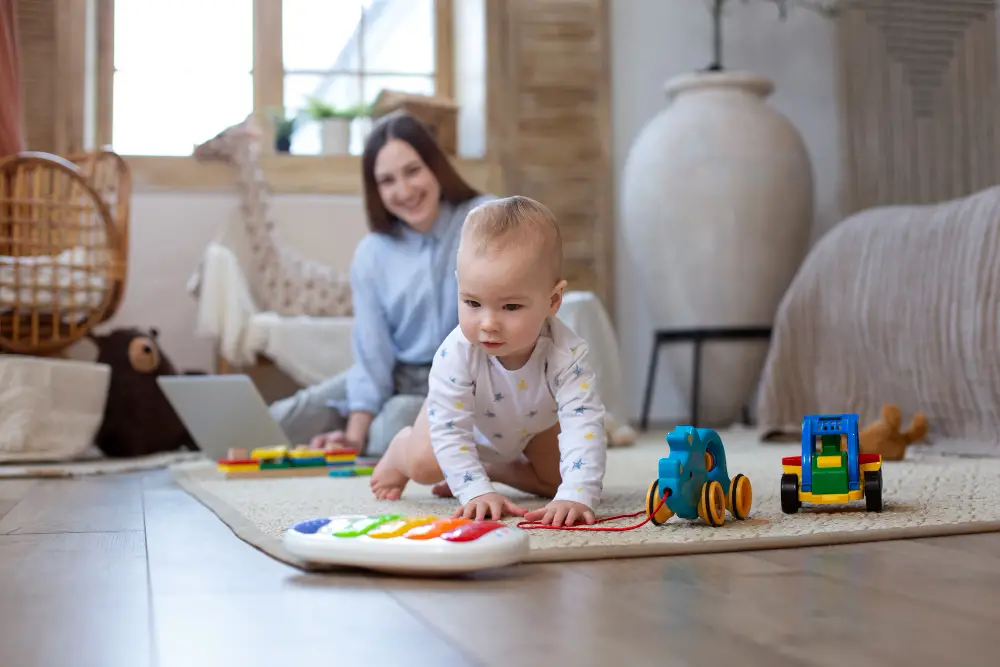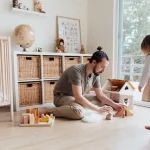Designing a baby nursery is an exciting journey filled with possibilities. It’s a chance to create a captivating and comforting space for your little one, where their growth, imagination, and joy can flourish. With innovative ideas and a touch of enchantment, you can transform a simple room into a magical haven that nurtures and inspires. Join us as we embark on this exploration of creating a baby nursery that is truly extraordinary.

Choosing the Perfect Color Palette:
Color plays a crucial role in creating a harmonious and visually appealing baby nursery. By carefully selecting the right color palette, you can set the tone for a serene and enchanting atmosphere that stimulates your baby’s senses and fosters a sense of calm and comfort. Let’s explore two delightful approaches to color selection:
Embracing Serenity: Exploring Soft Pastels and Calming Hues:
Soft pastel colors have long been associated with tranquility and serenity, making them an excellent choice for a baby’s nursery. Delicate shades of pink, baby blue, lavender, and mint green can create a soothing and peaceful environment. These gentle hues promote relaxation and are known to have a calming effect, ideal for nap times and bedtime routines. Consider incorporating pastel tones in the walls, bedding, curtains, and accessories to infuse the room with a sense of tranquility and tenderness.
Vibrant and Playful: Incorporating Bold Colors and Patterns:
If you prefer a more lively and dynamic nursery, bold colors and patterns can bring an element of vibrancy and playfulness to the space. Opt for vibrant primary colors like red, blue, and yellow, or explore bright shades of orange, green, and purple. Introduce these colors through accent walls, furniture pieces, rugs, or playful patterns on curtains and bedding. Bold colors can stimulate your baby’s visual senses and foster a cheerful and energetic ambiance, perfect for creating an engaging and stimulating environment.
Remember, when selecting a color palette, it’s essential to strike a balance between soothing and stimulating elements. You can even combine both approaches, using a soft pastel base and adding pops of vibrant colors through accessories or artwork. Let your creativity guide you in designing a color scheme that reflects your baby’s personality and creates a magical and inviting nursery space.
Stay tuned for the next sections, where we will delve into creating a cozy and comfortable atmosphere, personalizing with thoughtful decor, and enhancing functionality and organization in your baby’s nursery.
Creating a Cozy and Comfortable Atmosphere:

In a baby nursery, the crib serves as the centerpiece and sanctuary for your little one. It’s where countless hours of sweet dreams and peaceful slumbers unfold. Ensuring that you find the right crib is essential for creating a cozy and comfortable atmosphere that promotes restful sleep and nurtures your baby’s well-being. Let’s explore how you can choose the perfect crib to transform your nursery into a haven of tranquility.
Finding the Right Crib: A Haven for Sweet Dreams:
- Prioritize Safety: Safety should be your top priority when selecting a crib for your baby. Look for cribs that meet the latest safety standards, have sturdy construction, and feature fixed sides with secure hardware. Avoid cribs with decorative cutouts or excessive embellishments that could pose a safety risk.
- Consider Size and Adjustability: Cribs come in various sizes and shapes, so it’s crucial to consider the dimensions of your nursery and choose a crib that fits comfortably within the space. Additionally, opt for a crib that offers adjustable mattress heights, allowing you to lower the mattress as your baby grows to prevent climbing accidents.
- Opt for Comfort and Support: A comfortable crib mattress is essential for promoting quality sleep. Look for a firm mattress that provides adequate support for your baby’s growing body. Consider materials that are hypoallergenic and breathable, ensuring a safe and comfortable sleep environment.
- Style and Design: The crib’s aesthetic appeal should align with your nursery theme and personal taste. Whether you prefer a classic, modern, or eclectic design, choose a crib that complements the overall style of the room. Pay attention to the crib’s finish, color, and decorative elements, ensuring they blend harmoniously with the nursery decor.
- Functional Features: Some cribs offer additional features that can enhance functionality and convenience. These may include storage drawers, convertible options that transform into toddler beds, or adjustable side rails. Evaluate your needs and choose a crib that offers the desired features to optimize the functionality of your nursery space.
Remember, the crib is not just a functional piece of furniture; it sets the tone for the entire nursery. By selecting a crib that combines safety, comfort, style, and functionality, you can create a cozy and comfortable atmosphere where your baby can rest peacefully and embark on a journey of sweet dreams. Stay tuned for the next sections, where we will explore delightful ideas for personalizing your baby’s nursery with thoughtful decor and enhancing functionality and organization.
Personalizing with Thoughtful Decor:
To infuse your baby’s nursery with charm and create a space that truly reflects their unique personality, thoughtful decor plays a key role. By incorporating adorable wall art and incorporating soft and snuggly textiles, you can add a touch of warmth, creativity, and comfort to the nursery. Let’s explore these delightful ideas for personalizing your baby’s special haven.
Adorable Wall Art: Sparking Imagination:
- Playful Murals: Transform a blank wall into a captivating masterpiece by opting for whimsical murals. Choose designs that feature cute animals, enchanting landscapes, or dreamy characters. This artistic touch will stimulate your baby’s imagination and create a visually engaging focal point in the nursery.
- Gallery of Memories: Display a collection of cherished photographs, capturing precious moments of your baby’s journey. Create a gallery wall using stylish frames and arrange them in a creative and visually pleasing manner. This personalized touch will add warmth and a sense of connection to the nursery.
- Inspirational Quotes: Choose uplifting and inspiring quotes that resonate with your values and aspirations. Display them on the walls using decorative decals or framed prints. These positive messages will not only add a decorative element but also create a nurturing and motivating environment for your little one.
Soft and Snuggly Textiles: Adding Warmth and Texture:
- Cozy Blankets and Quilts: Layer the crib or a cozy reading nook with soft and snuggly blankets or quilts. Opt for materials like plush fleece or cotton that provide warmth and comfort. Choose patterns and colors that complement the nursery’s theme and add a touch of coziness to the space.
- Plush Rugs and Play Mats: Cover the nursery floor with a plush rug or play mat that offers a soft and cushioned surface for your baby to crawl, play, and explore. Select rugs in playful designs or soothing colors to enhance the visual appeal of the nursery while providing a comfortable play area.
- Decorative Pillows and Cushions: Add decorative pillows and cushions to seating areas or a cozy reading corner. Choose soft fabrics and delightful patterns that match the nursery’s theme, providing a cozy spot for bonding moments with your baby.
By incorporating adorable wall art and incorporating soft and snuggly textiles, you can personalize your baby’s nursery, creating a space filled with warmth, creativity, and comfort. Stay tuned for the next section, where we will explore ideas for enhancing functionality and organization in your baby’s nursery.
Enhancing Functionality and Organization:

An organized and functional nursery is essential for creating a stress-free environment that caters to your baby’s needs. With clever storage solutions, you can optimize space, keep essentials within reach, and maintain a tidy and efficient nursery. Let’s explore ideas for making room for essentials and maximizing functionality in your baby’s special space.
Clever Storage Solutions: Making Room for Essentials:
- Multi-Purpose Furniture: Choose furniture pieces that serve dual purposes and offer built-in storage. For example, opt for a changing table with drawers or shelves underneath, or select a crib with a built-in storage compartment. These functional furniture items provide a convenient way to store diapers, clothing, toys, and other essentials while maximizing space.
- Wall Shelving and Floating Shelves: Utilize the vertical space in the nursery by installing wall shelving or floating shelves. These provide a stylish and practical solution for displaying books, stuffed animals, and decorative items, while keeping them easily accessible and organized. Consider incorporating decorative baskets or bins on the shelves for additional storage options.
- Closet Organizers: Make the most of the nursery closet by installing organizers such as hanging shelves, dividers, and storage bins. These help maximize space and create designated areas for clothing, shoes, blankets, and accessories. Utilize hooks or hanging organizers on the closet doors for quick access to frequently used items.
- Under-Crib Storage: If your crib has ample space underneath, utilize it for storage. Invest in shallow storage bins or rolling drawers that can easily slide in and out. This space is perfect for storing extra bedding, blankets, or seasonal clothing.
- Toy Chests and Baskets: Keep toys organized and easily accessible by incorporating toy chests or large baskets in the nursery. These containers can be decorative elements themselves, adding a touch of charm while providing a designated spot for toy storage. Encourage your little one to participate in cleaning up by making it a fun and engaging activity.
By implementing these clever storage solutions, you can make the most of your baby’s nursery space, keeping essentials organized and within reach. A well-organized nursery not only enhances functionality but also creates a calm and inviting atmosphere for both you and your baby. In the next section, we will conclude with a summary and offer closing thoughts on designing the perfect baby nursery.
The process of designing a baby nursery is an exciting and fulfilling endeavor that allows you to create a truly magical space for your little one. By incorporating delightful ideas such as choosing the perfect color palette, finding the right crib, personalizing with thoughtful decor, and enhancing functionality and organization, you can craft a nursery that nurtures growth, imagination, and joy.
Remember, the color palette sets the tone for the nursery, whether you opt for serene pastels or vibrant and playful hues. The crib becomes a haven for sweet dreams, prioritizing safety, comfort, and style. Personalizing the nursery with adorable wall art and soft textiles adds warmth, creativity, and a personal touch to the space. Lastly, clever storage solutions ensure functionality and organization, making room for essentials and maintaining a stress-free environment.
As you embark on this wonderful journey of designing the perfect baby nursery, let your creativity soar. Trust your instincts and choose elements that resonate with your vision and reflect your baby’s unique personality. Whether you prefer a serene sanctuary or a vibrant wonderland, infuse the nursery with love, warmth, and imagination.
Enjoy every moment of the process and create a space where your little one can thrive and grow. Cherish the precious memories that will unfold in this magical haven, knowing that you have crafted a nurturing environment that will support your baby’s development and bring joy to both of you.
Non-Toxic Paint: Creating a Safe and Healthy Nursery Environment
Understanding the Importance of Non-Toxic Paint: Benefits for your Baby’s Health:

When it comes to designing a baby nursery, one of the essential considerations is choosing baby non-toxic paint. Traditional paints often contain harmful chemicals, known as volatile organic compounds (VOCs), that can release toxic fumes into the air, contributing to indoor air pollution. By opting for non-toxic paint, you can create a safe and healthy environment for your baby. Here are the key benefits of using non-toxic paint in the nursery:
- Reduced Exposure to Harmful Chemicals: Non-toxic paints are formulated without or with minimal amounts of VOCs and other harmful chemicals. This significantly reduces the risk of your baby inhaling or absorbing these toxins, which can have adverse health effects such as respiratory issues, allergies, and even long-term developmental problems.
- Improved Air Quality: Traditional paints release fumes and odors known as off-gassing, which can linger in the air for an extended period. Non-toxic paint emits significantly fewer or no fumes, contributing to better indoor air quality. This is especially important in a nursery, where babies spend a significant amount of time breathing in the air within that space.
- Allergy and Asthma-Friendly: Babies are more susceptible to allergies and respiratory issues due to their developing immune systems. Non-toxic paint helps minimize the risk of triggering allergies or asthma attacks since it does not contain harsh chemicals or irritants that can exacerbate these conditions.
Choosing Non-Toxic Paint Brands: Factors to Consider:
When selecting non-toxic paint for your baby’s nursery, it’s important to consider certain factors to ensure you’re making the safest choice. Here are some key considerations when choosing non-toxic baby paint brands:
- Look for Certifications: Look for paints that are certified as low or zero VOC by reputable organizations such as Green Seal, Greenguard, or LEED. These certifications ensure that the paint has undergone rigorous testing to meet specific safety and environmental standards.
- Check Ingredients and Formulas: Read the paint labels and avoid products that contain harmful chemicals such as formaldehyde, benzene, or heavy metals like lead. Opt for paints that use natural or plant-based pigments and binders.
- Research Brand Reputation: Research the reputation of the paint brand you are considering. Look for customer reviews, certifications, and any independent testing or endorsements that validate their claims of being non-toxic.
Tips for Painting the Baby Nursery: Ensuring a Safe and Fume-Free Environment:
When it’s time to paint the nursery, follow these tips to ensure a safe and fume-free environment for your baby:
- Choose a Well-Ventilated Time: Plan to paint the nursery when you can open windows and allow fresh air to circulate. Adequate ventilation helps disperse any fumes or odors from the paint, reducing the risk of exposure.
- Use Low or No VOC Primers and Paints: Start with a non-toxic primer specifically designed for the type of surface you are painting. Follow it up with low or no VOC paint in your desired colors. These products are readily available in many paint stores and offer a wide range of color options.
- Take Precautionary Measures: Protect yourself and your baby by wearing a mask, gloves, and appropriate clothing while painting. Cover any furniture or items that cannot be moved out of the room to prevent paint splatters or spills.
- Allow Sufficient Drying Time: Ensure the room is completely dry and free of any residual paint odors before allowing your baby to occupy the nursery. Follow the manufacturer’s instructions regarding drying time.
By understanding the importance of non-toxic paint, choosing non-toxic paint brands, and following tips for painting the nursery, you can create a safe and fume-free environment for your baby. Prioritizing your baby’s health and well-being by using non-toxic paint ensures that they can thrive in a nursery free from harmful chemicals and pollutants.
Remember, the nursery is a space where your baby will spend a significant amount of time sleeping, playing, and growing. By taking the necessary precautions and making informed choices, you can provide them with a nurturing environment that promotes their health and development.
As you begin the process of selecting non-toxic paint for your baby’s nursery, look for certifications from reputable organizations that validate the low or zero VOC content of the paint. Read labels carefully, avoiding paints that contain harmful chemicals or heavy metals. Research the reputation of the brand and consider feedback from other customers who have used their products.
When it comes time to paint the nursery, choose a well-ventilated time and open windows to allow fresh air circulation. Use low or no VOC primers and paints, following the manufacturer’s instructions for application and drying time. Take precautionary measures by wearing protective gear and covering furniture or items that cannot be moved.
By incorporating these considerations and following the tips provided, you can ensure that your baby’s nursery is a safe and healthy environment. Embrace the peace of mind that comes with knowing you have created a space where your baby can thrive without the risks associated with toxic paint.
Designing a nursery that prioritizes your baby’s health sets the foundation for their overall well-being. With non-toxic paint, you can create a beautiful and safe haven that reflects your style while providing a nurturing and healthy environment for your little one. Enjoy the process of creating a nursery that is not only visually appealing but also promotes the well-being of your baby.
Baby Organic Crib Mattresses: Prioritizing Comfort and Health
When it comes to creating a safe and cozy sleeping environment for your baby, choosing an organic crib mattress is a decision that can have a significant impact on their comfort and overall health. Organic crib mattresses are crafted using natural materials that are free from harmful chemicals and toxins, providing a nurturing and safe space for your little one to rest. Let’s explore the benefits of organic crib mattresses, what to look for when selecting one, and essential maintenance and care tips.

Benefits of Organic Crib Mattresses: Why They’re Worth Considering
Organic crib mattresses offer numerous advantages that make them a worthwhile investment for your baby’s nursery. Here are some key benefits of choosing an organic crib mattress:
- Chemical-Free and Non-Toxic: Organic crib mattresses are made from natural materials such as organic cotton, organic wool, and natural latex. These materials are grown or sourced without the use of pesticides, synthetic fertilizers, or harmful chemicals, ensuring that your baby is not exposed to potentially harmful substances while they sleep.
- Allergen-Free and Hypoallergenic: Organic crib mattresses are naturally resistant to common allergens such as dust mites, mold, and mildew. This reduces the risk of triggering allergies or respiratory issues, making them ideal for babies with sensitive skin or allergies.
- Breathable and Temperature-Regulating: The natural materials used in organic crib mattresses allow for better airflow, helping to regulate your baby’s body temperature while they sleep. This promotes a comfortable and safe sleep environment, reducing the risk of overheating.
- Sustainable and Eco-Friendly: Organic crib mattresses are manufactured using sustainable practices that have a minimal impact on the environment. Choosing an organic mattress demonstrates your commitment to sustainability and reduces your baby’s carbon footprint.
What to Look for in an Organic Crib Mattress: Materials and Certifications
When selecting an organic crib mattress, it’s important to consider the materials used and look for relevant certifications. Here are some key factors to consider:
- Organic Materials: Look for mattresses made from certified organic materials such as organic cotton, organic wool, and natural latex. Ensure that the materials used are free from pesticides, herbicides, and synthetic chemicals.
- Certifications: Check for certifications such as Global Organic Textile Standard (GOTS) and Global Organic Latex Standard (GOLS), which ensure that the mattress meets strict organic and sustainability standards. These certifications provide assurance that the mattress has been independently tested and verified.
- Firmness and Support: Choose a crib mattress that provides the right level of firmness and support for your baby’s growing body. A firm mattress is recommended to reduce the risk of suffocation and promote proper spinal alignment.
Maintenance and Care Tips for Organic Crib Mattresses
To ensure the longevity and cleanliness of your organic crib mattress, follow these essential maintenance and care tips:
- Use a Waterproof Mattress Protector: Invest in a waterproof and breathable mattress protector to safeguard the mattress from spills, accidents, and stains. Look for protectors made from organic materials that are free from vinyl, phthalates, and other harmful chemicals.
- Regularly Clean and Air Out the Mattress: Clean the mattress periodically by vacuuming it to remove any dust or debris. Additionally, allow the mattress to air out in a well-ventilated area to prevent moisture buildup and odors.
- Rotate the Mattress: To promote even wear and maintain its shape, rotate the mattress every few months. This helps distribute pressure and extends the lifespan of the mattress.
- Follow Manufacturer’s Guidelines: Always refer to the manufacturer’s instructions for specific care recommendations tailored to your organic crib mattress. This ensures that you are properly caring for the mattress and maintaining its warranty.
- Respond to Spills and Stains Promptly: In the event of spills or accidents, quickly blot the affected area with a clean cloth to absorb moisture. Avoid using harsh chemicals or cleaners that may damage the organic materials. Instead, opt for natural cleaning solutions or consult the manufacturer for appropriate stain removal techniques.
- Avoid Excessive Moisture: Keep the mattress dry and avoid exposing it to excessive moisture. Moisture can lead to the growth of mold and mildew, compromising the integrity of the mattress. If necessary, use a dehumidifier or ensure proper ventilation in the nursery.
- Monitor for Wear and Tear: Regularly inspect the mattress for signs of wear, such as sagging or lumps. If you notice any significant changes in the mattress’s structure or support, consider replacing it to maintain a safe and comfortable sleeping surface for your baby.
By considering the materials, certifications, and benefits of organic crib mattresses, you can make an informed choice that prioritizes your baby’s comfort and health. Remember to follow proper maintenance and care practices to ensure the longevity and cleanliness of the mattress.
Investing in an organic crib mattress not only provides a cozy and comfortable sleeping environment for your baby but also contributes to a healthier and more sustainable nursery. With their non-toxic and hypoallergenic properties, organic crib mattresses offer peace of mind, knowing that your baby is sleeping on a mattress free from harmful chemicals and allergens.
Create a nurturing and safe haven for your little one by choosing an organic crib mattress that aligns with your values of comfort, health, and sustainability. Enjoy the journey of parenthood knowing that you have made a thoughtful and beneficial choice for your baby’s sleep environment.
Baby Natural Fiber Rugs: Eco-Friendly and Soft Flooring Options
When it comes to designing a nursery, the choice of flooring plays a crucial role in creating a comfortable and safe space for your baby. Natural fiber rugs offer an excellent solution by providing an eco-friendly and soft flooring option that adds warmth, texture, and style to the nursery. Let’s explore the advantages of natural fiber rugs, popular materials to consider, and essential cleaning and maintenance tips.

Advantages of Natural Fiber Rugs for the Nursery: A Sustainable Choice
Natural fiber rugs offer several advantages that make them a sustainable and practical choice for the nursery. Here are some key benefits:
- Eco-Friendly: Natural fiber rugs are made from renewable resources such as plant fibers, making them an environmentally friendly option. These rugs are biodegradable, reducing their impact on the planet compared to synthetic alternatives.
- Softness and Comfort: Natural fiber rugs, such as those made from materials like jute, sisal, or bamboo, provide a soft and comfortable surface for your baby to crawl, play, and explore. These rugs offer a cozy and inviting feel to the nursery.
- Breathability and Air Quality: Natural fiber rugs allow for better air circulation, contributing to improved indoor air quality in the nursery. They do not release harmful chemicals or volatile organic compounds (VOCs) that can negatively affect your baby’s health.
- Durability: Natural fiber rugs are known for their durability and ability to withstand heavy foot traffic. This is especially important in the nursery, where babies and young children spend a lot of time playing and crawling on the floor.
Popular Natural Fiber Rug Materials: Exploring Options
There are various natural fiber materials available for rugs that are suitable for the nursery. Here are a few popular options to consider:
- Jute: Jute rugs are soft, natural, and known for their earthy appearance. They add a warm and cozy touch to the nursery and are often highly durable.
- Sisal: Sisal rugs are sturdy and provide a natural, textured look. They are an excellent choice for high-traffic areas of the nursery and offer good resistance to stains.
- Seagrass: Seagrass rugs have a smooth texture and natural sheen. They are highly durable, stain-resistant, and suitable for babies with allergies or sensitivities.
- Bamboo: Bamboo rugs have a smooth and sleek appearance and provide a comfortable surface for the nursery. They are eco-friendly, durable, and resistant to moisture.
Caring for Natural Fiber Rugs: Cleaning and Maintenance Tips
To keep your natural fiber rug clean and well-maintained in the nursery, follow these essential tips:
- Regular Vacuuming: Vacuum the rug regularly to remove dirt, dust, and debris. Use a vacuum cleaner with a brush attachment or a suction-only setting to avoid damaging the fibers.
- Blotting Spills: In case of spills or accidents, promptly blot the area with a clean cloth or paper towel. Avoid rubbing, as it can push the liquid deeper into the fibers. For stubborn stains, consult professional rug cleaners who specialize in natural fiber rugs.
- Avoid Excessive Moisture: Natural fiber rugs are susceptible to moisture damage. Avoid placing them in areas prone to spills or excessive moisture. If the rug becomes wet, allow it to air dry completely before using it again to prevent mold or mildew growth.
- Rotate the Rug: To ensure even wear and sun exposure, periodically rotate the rug in the nursery. This helps prevent one area from experiencing excessive fading or wear.
- Protect from Direct Sunlight: Prolonged exposure to direct sunlight can cause fading and damage to natural fiber rugs. Use curtains, blinds, or UV-protective window film to minimize the rug’s exposure to sunlight.
- Use Rug Pads: Place a non-slip rug pad underneath the natural fiber rug to prevent it from sliding and to provide extra cushioning. Rug pads also help protect the floor beneath the rug.
- Avoid Harsh Chemicals: When cleaning the rug, avoid using harsh chemicals or cleaners that may damage the natural fibers. Instead, opt for gentle, natural cleaning solutions or consult the manufacturer’s recommendations.
- Professional Cleaning: Consider professional rug cleaning services for deep cleaning and maintenance. They have expertise in handling natural fiber rugs and can ensure proper care without causing damage.
By choosing natural fiber rugs for the nursery, you not only create a soft and comfortable flooring surface but also contribute to a more sustainable and eco-friendly environment. With their durability and natural beauty, these rugs enhance the overall aesthetic of the nursery while providing a safe space for your baby to play and explore.
Embrace the natural charm and texture of natural fiber rugs as you design a nurturing and cozy nursery for your little one. With proper cleaning and maintenance, these rugs will continue to add warmth and style to the nursery for years to come.
Conclusion
Designing a baby nursery involves careful consideration of various elements to create a captivating, comfortable, and safe space for your little one. From the color palette to the crib mattress, and from the rugs to the non-toxic paint, each component plays a significant role in shaping the nursery environment.
By prioritizing the use of non-toxic paint, you ensure that your baby is surrounded by a safe and healthy atmosphere, free from harmful chemicals. Choosing organic crib mattresses allows for a restful sleep and reduces exposure to allergens and toxins commonly found in conventional mattresses. Natural fiber rugs provide a sustainable and soft flooring option that adds warmth and texture to the nursery while contributing to a healthier indoor environment.
Throughout the design process, it is essential to consider factors such as comfort, functionality, and sustainability. By personalizing the nursery with thoughtful decor, incorporating adorable wall art and soft textiles, and implementing clever storage solutions, you create a space that not only nurtures your baby’s growth but also reflects your style and values as a parent.
Maintaining the nursery and its components through regular cleaning and proper care ensures their longevity and continued benefits. From choosing eco-friendly cleaning products to rotating the rugs and following manufacturer’s guidelines, these practices help preserve the nursery’s overall appeal and functionality.
As you embark on the journey of designing your baby’s nursery, let your creativity soar and be mindful of creating a magical haven that promotes growth, imagination, and joy. By integrating these ideas, materials, and practices, you can craft a nursery that offers a safe, comforting, and inspiring environment for your little one to thrive and flourish.
Remember, every detail, from the non-toxic paint on the walls to the natural fiber rugs on the floor, contributes to the overall well-being of your baby. Enjoy the process of creating a nursery that reflects your love and care, and cherish the precious moments spent with your little one in this enchanting space.
Congratulations on this beautiful milestone, and may your baby nursery be a place of love, comfort, and endless possibilities.



